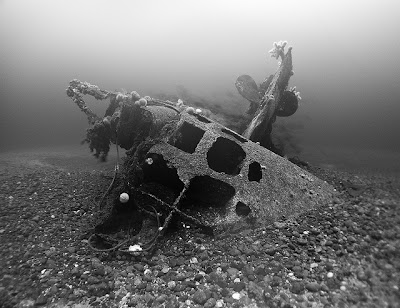El destino del U-2511
El U-2511 fue ordenado el 6 de noviembre de 1943 siendo botado el 2 de junio de 1944 en los astilleros de Blohm und Voß, Hamburgo. Su primera patrulla la realizó, sin embargo, el 17 de marzo de 1945 realizando otras dos más hasta su regreso de la 3º patrulla el 20 de abril de ese mismo año sin mucho éxito.
El 3 de mayo volvió a zarpar y sería la primera patrulla de guerra que realizaba un submarino Tipo XXI. Su destino final era el Caribe dónde atacaría el tráfico marítimo aliado en esa zona. Sin embargo un día después recibió la orden de regresar a la base pero el submarino división un Grupo Naval compuesto por un crucero y varios destructores de escolta que navegaba al norte de las islas Feroes. El U-2511 se situó a tan solo 500 metros del crucero HMS Norfolk sin ser detectado por los sonar de los destructores ya que este tipo de U-Boot eran los más silenciosos. Sin razón aparente su capitán, el Adalbert Schnee, no atacó al crucero aún teniéndolo a tiro.
Poco después el U-2511, que estaba navegando con su Schnorkel, decidió bajarlo para aumentar su velocidad y escapar de la formación enemiga. El 6 de mayo alcanzó la base de Bergen sin mayores problemas. El 9 de mayo se rindió a los aliados en Bergen siendo enviado a Inglaterra el día 30.
El U-2511 se convertiría en uno de los 116 U-Boot hundidos por la Royal Navy en la operación Deadlight. Su destino fue ser hundido a cañonazos el 7 de enero de 1946 por la fragata HMS. Sole Bay al noroeste de Malin Head.
U-2511 junto a otros U-Boote
Fuentes:
NIESTLE, A. “German U-Boot losses during World War II ” Naval Institute Press 1998
BLAIR, C. “Hitler´s U-Boat war” Random House, 1998
WYNN, K. “U-Boat operations of the Second World War” Naval Institute Press 1998
English version
The U-2511 was ordained on November 6, 1943 to be launched on June 2, 1944 at the Blohm und Voss, Hamburg. His first patrol made it, however, the March 17, 1945 by two more until his return from the 3rd patrol on April 20 of that year without much success.
The May 3 and would sail back to the first war patrol conducted a Type XXI submarine. Their final destination was the Caribbean where they would attack the Allied shipping in the area. But a day later was ordered to return to base but the submarine division Naval Group composed of a cruiser and several destroyers to escort sailed north of the Faroe Islands. The U-2511 stood at only 500 meters from the cruiser HMS Norfolk without being detected by the sound of the destroyers as this type of U-boats were the quietest. For no apparent reason captain Adalbert Schnee, not even having it attacked the cruise ship in range.
The May 3 and would sail back to the first war patrol conducted a Type XXI submarine. Their final destination was the Caribbean where they would attack the Allied shipping in the area. But a day later was ordered to return to base but the submarine division Naval Group composed of a cruiser and several destroyers to escort sailed north of the Faroe Islands. The U-2511 stood at only 500 meters from the cruiser HMS Norfolk without being detected by the sound of the destroyers as this type of U-boats were the quietest. For no apparent reason captain Adalbert Schnee, not even having it attacked the cruise ship in range.
Shortly after the U-2511, which was sailing with his Schnorkel, decided to lower it to increase its speed and escape the enemy formation. On May 6, reached the base of Bergen without major problems. On May 9, surrendered to the Allies in Bergen being sent to England on the 30th.
The U-2511 became one of the 116 U-boats sunk by the Royal Navy in the operation Deadlight. His fate was to be sunk by gunfire on January 7, 1946 by the frigate HMS. Sole Bay northwest of Malin Head.
Sources:
NIESTLE, A. “German U-Boot losses during World War II ” Naval Institute Press 1998
BLAIR, C. “Hitler´s U-Boat war” Random House, 1998
WYNN, K. “U-Boat operations of the Second World War” Naval Institute Press 1998








No hay comentarios:
Publicar un comentario